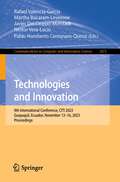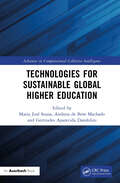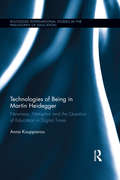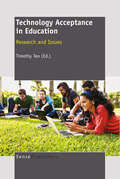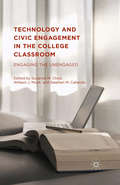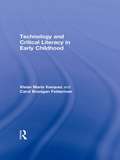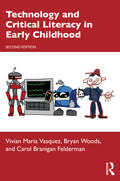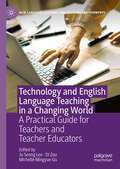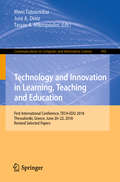- Table View
- List View
Technologies and Innovation: 8th International Conference, CITI 2022, Guayaquil, Ecuador, November 14–17, 2022, Proceedings (Communications in Computer and Information Science #1658)
by Rafael Valencia-García Martha Bucaram-Leverone Javier Del Cioppo-Morstadt Néstor Vera-Lucio Emma Jácome-MurilloThis book constitutes the refereed proceedings of the 8th International Conference, CITI 2022, held in Guayaquil, Ecuador, during November 14–17, 2022.The 19 full papers included in this book were carefully reviewed and selected from 48 submissions. They were organized in topical sections as follows: machine Learning; knowledge based systems; computer vision and image analysis; networks, monitoring and collaborative systems; apps and user interfaces.
Technologies and Innovation: 9th International Conference, CITI 2023, Guayaquil, Ecuador, November 13–16, 2023, Proceedings (Communications in Computer and Information Science #1873)
by Rafael Valencia-García Martha Bucaram-Leverone Javier Del Cioppo-Morstadt Néstor Vera-Lucio Pablo Humberto Centanaro-QuirozThis book constitutes the refereed proceedings of the 9th International Conference on Technologies and Innovation, CITI 2023, held in Guayaquil, Ecuador, during November 13–16, 2023. The 20 full papers included in this book were carefully reviewed and selected from 51 submissions. They were organized in topical sections as follows: Machine Learning; Natural Language Processing and Semantic Web; Computer vision; and Knowledge-based systems.
Technologies for E-Learning and Digital Entertainment: Second International Conference, Edutainment 2007, Hong Kong, China, June 11-13, 2007, Proceedings (Lecture Notes in Computer Science #4469)
by Kin-Chuen Hui Zhigeng Pan Ronald Chi-Kit Chung Charlie C. L. Wang Xiaogang Jin Stefan Göbel Eric C. L. LiThis book constitutes the refereed proceedings of the Second International Conference on E-learning and Games, Edutainment 2007, held in Hong Kong, China, in June 2007. It covers virtual and augmented reality in game and education, virtual characters in games and education, e-learning platforms and tools, geometry in games and virtual reality, vision, imaging and video technology, as well as collaborative and distributed environments.
Technologies for E-Learning and Digital Entertainment: First International Conference, Edutainment 2006, Hangzhou, China, April 16-19, 2006, Proceedings (Lecture Notes in Computer Science #3942)
by Zhigeng Pan Stefan Göbel Ruth Aylett Holger Diener Xiaogang Jin Li LiThis book constitutes the refereed proceedings of the First International Conference on E-learning and Games, Edutainment 2006, held in Hangzhou, China in April 2006. The 121 revised full papers and 52 short papers presented together with the abstracts of 3 invited papers and those of the keynote speeches cover a wide range of topics, including e-learning platforms and tools, learning resource management, practice and experience sharing, e-learning standards, and more.
Technologies for Sustainable Global Higher Education (Advances in Computational Collective Intelligence)
by Maria José Sousa Andreia de Bem Machado Gertrudes Aparecida DandoliniDigital technologies are influencing the way we learn, live, work, and exist in different contexts of society in the digital age. There are a variety of learning systems that support innovative digital approaches, and universities and organizations around the world are investing in building their own e-learning platforms. Digital technologies are enabling wider access to education and new markets for student recruitment, resulting in increased income prospects for global higher education institutions. Technology enables numerous data and information sources, which give greater access to information and data. It also enables highly virtual environments, which impact teaching and the classroom. The widespread use and application of digital technologies in the teaching and learning process provoke pedagogical inquiry and mediation. It is in this context that Technologies for Sustainable Global Higher Education focuses on analyzing the application of digital technologies in the teaching–learning process. The chapters in this edited collection seek to answer questions relevant to the context of higher education, such as: What is the concept of digital technologies? How is digital technology used to mediate the learning process? What technologies are used to qualify education in higher education? This book provides answers to these questions by focusing on issues central to improving education through digital technologies, digital learning, and pedagogical practices in digital education. It also provides case studies of higher education institutions.
Technologies for Sustainable Global Higher Education (Advances in Computational Collective Intelligence)
by Maria José Sousa Andreia De Bem Machado Gertrudes Aparecida DandoliniDigital technologies are influencing the way we learn, live, work, and exist in different contexts of society in the digital age. There are a variety of learning systems that support innovative digital approaches, and universities and organizations around the world are investing in building their own e-learning platforms. Digital technologies are enabling wider access to education and new markets for student recruitment, resulting in increased income prospects for global higher education institutions. Technology enables numerous data and information sources, which give greater access to information and data. It also enables highly virtual environments, which impact teaching and the classroom. The widespread use and application of digital technologies in the teaching and learning process provoke pedagogical inquiry and mediation. It is in this context that Technologies for Sustainable Global Higher Education focuses on analyzing the application of digital technologies in the teaching–learning process. The chapters in this edited collection seek to answer questions relevant to the context of higher education, such as: What is the concept of digital technologies? How is digital technology used to mediate the learning process? What technologies are used to qualify education in higher education? This book provides answers to these questions by focusing on issues central to improving education through digital technologies, digital learning, and pedagogical practices in digital education. It also provides case studies of higher education institutions.
Technologies in Biomedical and Life Sciences Education: Approaches and Evidence of Efficacy for Learning (Methods in Physiology)
by Harry J. Witchel Michael W. LeeThis contributed volume focuses on understanding the educational strengths and weaknesses of mediated content (including media as a learning supplement), in comparison to traditional face-to-face learning. Each chapter includes research on, and a broad-brush summary of, approaches to combining life sciences education with educational technologies. The chapters are organized into four main sections, each of which focuses on a key question regarding the consequences of incorporating media into education. In this regard, the authors highlight how educational technology is both a bridge and barrier to student access and inclusivity. Further, they address the ongoing discussion as to whether students need to be present for lectures, and on how having agency in their own learning can improve both retention and conceptual understanding. To link the content to current events, the authors also shed light on the impact that the COVID-19 pandemic is having on the continuity of educational programs and on the growing importance of educational technologies. Consequently, the book offers life science educators valuable guidance on the technologies already available, and an outlook on what is yet to come.
Technologies of Being in Martin Heidegger: Nearness, Metaphor and the Question of Education in Digital Times (Routledge International Studies in the Philosophy of Education)
by Anna KouppanouTechnologies of Being in Martin Heidegger attempts to deepen the dialogue between philosophy of education and philosophy of technology, while engaging with the thought of Heidegger, Jacques Derrida and Bernard Stiegler. Through a critical reading of Heidegger’s central notion of nearness, this book argues that thinking is intricately conditioned by technologically produced images, which are themselves interacting with imagination’s schematizing power. The book further discusses how certain metaphorical synthesising processes, which are currently industrialized taking the form of social networking sites and search engines, discretise human behaviour and reorganise it in ways that often marginalise human interpretation and redefine nearness. Finally, it suggests how we might reconceptualise technology and education as processes of human individuation. Technologies of Being in Martin Heidegger will be of great interest to scholars in the fields of philosophy of education, philosophy of technology, literary studies, cognitive linguistics and cognitive neuroscience.
Technologies of Being in Martin Heidegger: Nearness, Metaphor and the Question of Education in Digital Times (Routledge International Studies in the Philosophy of Education)
by Anna KouppanouTechnologies of Being in Martin Heidegger attempts to deepen the dialogue between philosophy of education and philosophy of technology, while engaging with the thought of Heidegger, Jacques Derrida and Bernard Stiegler. Through a critical reading of Heidegger’s central notion of nearness, this book argues that thinking is intricately conditioned by technologically produced images, which are themselves interacting with imagination’s schematizing power. The book further discusses how certain metaphorical synthesising processes, which are currently industrialized taking the form of social networking sites and search engines, discretise human behaviour and reorganise it in ways that often marginalise human interpretation and redefine nearness. Finally, it suggests how we might reconceptualise technology and education as processes of human individuation. Technologies of Being in Martin Heidegger will be of great interest to scholars in the fields of philosophy of education, philosophy of technology, literary studies, cognitive linguistics and cognitive neuroscience.
Technologies of Seeing: Photography, Cinema and Television
by Brian WinstonThis text examines the complex forces pushing and constraining technological developments in cinema. It contests the view that technological advance is simply the result of scientific progress. Rather, the author argues that social forces control the media technology agenda at every stage.
Technologies of Seeing: Photography, Cinema and Television
by Brian WinstonThis text examines the complex forces pushing and constraining technological developments in cinema. It contests the view that technological advance is simply the result of scientific progress. Rather, the author argues that social forces control the media technology agenda at every stage.
Technology Acceptance in Education
by Timothy TeoTechnology acceptance can be defined as a user’s willingness to employ technology for the tasks it is designed to support. Over the years, acceptance researchers have become more interested in understanding the factors influencing the adoption of technologies in various settings. From the literature, much research has been done to understand technology acceptance in the business contexts. This is understandable, given the close relationship between the appropriate uses of technology and profit margin. In most of the acceptance studies, researchers have sought to identify and understand the forces that shape users’ acceptance so as to influence the design and implementation process in ways to avoid or minimize resistance or rejection when users interact with technology. Traditionally, it has been observed that developers and procurers of technological resources could rely on authority to ensure that technology was used, which is true in many industrial and organizational contexts. However, with the increasing demands for educational applications of information technology and changing working practices, there is s need to re-examine user acceptance issues as they emerge within and outside of the contexts in which technology was implemented. This is true in the education milieu where teachers exercise the autonomy to decide on what and how technology will be used for teaching and learning purposes. Although they are guided by national and local policies to use technology in the classrooms, teachers spent much of their planning time to consider how technology could be harnessed for effective lesson delivery and assessment to be conducted. These circumstances have provided the impetus for researchers to study technology acceptance in educational settings. Although these studies have typically involved students and teachers as participants, their findings have far-reaching implications for school leaders, policy makers, and other stakeholders. The book is a critical and specialized source that describes recent research on technology acceptance in education represented by educators and researchers from around the world such as Australia, Belgium, China, Hong Kong, Malaysia, Singapore, United Kingdom, and United States of America.
Technology and Adolescent Health: In Schools and Beyond
by Megan A. Moreno Andrea J. HoopesTechnology and Adolescent Health: In Schools and Beyond discusses how today's adolescents are digital natives, using technology at home and in school to access information, for entertainment, to socialize and do schoolwork. This book summarizes research on how technology use impacts adolescent mental health, sleep, physical activity and eating habits. In addition, it identifies monitoring and screening technology-based tools for use with adolescents.Summarizes the effects of digital technology use on adolescent mental healthAdvises on best practices for adolescent technology use in home and schoolsIdentifies digital tools to monitor adolescent healthIncludes effects on sleep, addiction, socialization, eating and exercise habitsProvides both the positive and negative consequences of technology use
Technology and Civic Engagement in the College Classroom: Engaging the Unengaged
by Stephen M. Caliendo William J. MuckTechnology and Civic Engagment in the College Clasroom is a theoretical and empirical examination of ways to foster civic engagement in Millennials. Each chapter contributes to understanding how both traditional and more innovative pedagogical tools can increase students' political interest and efficacy.
Technology and Competency-Oriented Learning: Effective Methods for Training the Next Cohort of Healthcare Managers
by Lior Naamati-Schneider Dorit AltThis book provides insights into the development of competency-based learning approaches and specific instructional activities designed to enhance healthcare management students’ twenty-first-century skills (21CS). These skills encompass three core domains: cognitive, intra-personal, and inter-personal. The book explores how these skills can be advanced within the intricate dynamics of healthcare systems at macro, meso, and micro levels, emphasizing the imperative need for healthcare professionals to adapt to rapid technological and global changes. Structured into twelve chapters, the book begins with an overview of the complex healthcare environment, highlighting transformative changes and challenges. It then delves into the core theme of competency-based learning, showcasing a shift from traditional teaching methods to constructivist approaches that enhance real-world skills through interactive methods. This approach is crucial for fostering the necessary skills in healthcare managers and other healthcare professionals, which are increasingly vital in today's digital and dynamic medical landscape. The book serves as an extensive resource and guide for healthcare students, faculty, researchers, curriculum designers, policymakers, and current and future healthcare leaders. It offers practical methodologies, innovative teaching methods, and insightful case studies, making it a valuable reference for healthcare and pedagogical research.
Technology and Critical Literacy in Early Childhood
by Vivian Maria Vasquez Carol Branigan FeldermanWhat do new technologies and new forms of communication mean for young children growing up in the 21st century? How are they shaping the mindsets, identities and practices which impact their lives at home and at school? This book explores the intersection of technology and critical literacy, specifically addressing what ICTs afford critical literacy work with young children between ages three to eight. Inviting readers to enter classrooms where both technology and critical literacies are woven into childhood curricula and teaching, it brings together literacy, social studies, and science in critical and integrated ways. Real-world stories show the sights and sounds of children engaged with technology in the classroom and beyond. Concise but comprehensive, the text provides strategies, theoretical frameworks, demonstrations of practice, and resources for teachers. Pedagogical features in each chapter engage readers in making connections to their own teaching situations. NCATE standards for including technology as an essential part of teacher education programs are addressed. While acknowledging how individual children employ ICT, the focus is on how new technologies can be positioned in early childhood learning communities as tools for engaging in more meaningful, authentic, and interesting learning.
Technology and Critical Literacy in Early Childhood
by Vivian Maria Vasquez Carol Branigan FeldermanWhat do new technologies and new forms of communication mean for young children growing up in the 21st century? How are they shaping the mindsets, identities and practices which impact their lives at home and at school? This book explores the intersection of technology and critical literacy, specifically addressing what ICTs afford critical literacy work with young children between ages three to eight. Inviting readers to enter classrooms where both technology and critical literacies are woven into childhood curricula and teaching, it brings together literacy, social studies, and science in critical and integrated ways. Real-world stories show the sights and sounds of children engaged with technology in the classroom and beyond. Concise but comprehensive, the text provides strategies, theoretical frameworks, demonstrations of practice, and resources for teachers. Pedagogical features in each chapter engage readers in making connections to their own teaching situations. NCATE standards for including technology as an essential part of teacher education programs are addressed. While acknowledging how individual children employ ICT, the focus is on how new technologies can be positioned in early childhood learning communities as tools for engaging in more meaningful, authentic, and interesting learning.
Technology and Critical Literacy in Early Childhood
by Vivian Maria Vasquez Bryan Woods Carol Branigan FeldermanNow in its second edition, this popular text explores classrooms where technology and critical literacies are woven into childhood curricula and teaching. Using real-world stories, it addresses what ICTs afford critical literacy with young children, and how new technologies can be positioned to engage in meaningful and authentic learning. Concise but comprehensive, the text provides strategies, theoretical frameworks, demonstrations of practice, and resources for teachers. Updated with discussions of media literacy and new pedagogical tools, the second edition features new classroom examples and experiences that highlight the ways in which critical literacy, technology and media literacy come together in everyday life in the early childhood classroom. The inviting examples model how to use the interests and inquiry questions of young learners as a springboard for creating a critical curriculum. Each chapter includes Reflection Points, pedagogical invitations, and Resource Boxes to imagine new possibilities of working with students in engaging and supportive ways. The inspiring stories, guidance, and tools this book make it a great resource for pre-service teachers and students in Early Childhood Education and Literacy Education, and primary teachers and educators.
Technology and Critical Literacy in Early Childhood
by Vivian Maria Vasquez Bryan Woods Carol Branigan FeldermanNow in its second edition, this popular text explores classrooms where technology and critical literacies are woven into childhood curricula and teaching. Using real-world stories, it addresses what ICTs afford critical literacy with young children, and how new technologies can be positioned to engage in meaningful and authentic learning. Concise but comprehensive, the text provides strategies, theoretical frameworks, demonstrations of practice, and resources for teachers. Updated with discussions of media literacy and new pedagogical tools, the second edition features new classroom examples and experiences that highlight the ways in which critical literacy, technology and media literacy come together in everyday life in the early childhood classroom. The inviting examples model how to use the interests and inquiry questions of young learners as a springboard for creating a critical curriculum. Each chapter includes Reflection Points, pedagogical invitations, and Resource Boxes to imagine new possibilities of working with students in engaging and supportive ways. The inspiring stories, guidance, and tools this book make it a great resource for pre-service teachers and students in Early Childhood Education and Literacy Education, and primary teachers and educators.
Technology and Digital Media in the Early Years: Tools for Teaching and Learning
by Chip DonohueA Co-Publication of Routledge and NAEYC Technology and Digital Media in the Early Years offers early childhood teacher educators, professional development providers, and early childhood educators in pre-service, in-service, and continuing education settings a thought-provoking guide to effective, appropriate, and intentional use of technology with young children. This book provides strategies, theoretical frameworks, links to research evidence, descriptions of best practice, and resources to develop essential digital literacy knowledge, skills and experiences for early childhood educators in the digital age. Technology and Digital Media in the Early Years puts educators right at the intersections of child development, early learning, developmentally appropriate practice, early childhood teaching practices, children’s media research, teacher education, and professional development practices. The book is based on current research, promising programs and practices, and a set of best practices for teaching with technology in early childhood education that are based on the NAEYC/FRC Position Statement on Technology and Interactive Media and the Fred Rogers Center Framework for Quality in Children’s Digital Media. Pedagogical principles, classroom practices, and teaching strategies are presented in a practical, straightforward way informed by child development theory, developmentally appropriate practice, and research on effective, appropriate, and intentional use of technology in early childhood settings. A companion website (http://teccenter.erikson.edu/tech-in-the-early-years/) provides additional resources and links to further illustrate principles and best practices for teaching and learning in the digital age.
Technology and Digital Media in the Early Years: Tools for Teaching and Learning
by Chip DonohueA Co-Publication of Routledge and NAEYC Technology and Digital Media in the Early Years offers early childhood teacher educators, professional development providers, and early childhood educators in pre-service, in-service, and continuing education settings a thought-provoking guide to effective, appropriate, and intentional use of technology with young children. This book provides strategies, theoretical frameworks, links to research evidence, descriptions of best practice, and resources to develop essential digital literacy knowledge, skills and experiences for early childhood educators in the digital age. Technology and Digital Media in the Early Years puts educators right at the intersections of child development, early learning, developmentally appropriate practice, early childhood teaching practices, children’s media research, teacher education, and professional development practices. The book is based on current research, promising programs and practices, and a set of best practices for teaching with technology in early childhood education that are based on the NAEYC/FRC Position Statement on Technology and Interactive Media and the Fred Rogers Center Framework for Quality in Children’s Digital Media. Pedagogical principles, classroom practices, and teaching strategies are presented in a practical, straightforward way informed by child development theory, developmentally appropriate practice, and research on effective, appropriate, and intentional use of technology in early childhood settings. A companion website (http://teccenter.erikson.edu/tech-in-the-early-years/) provides additional resources and links to further illustrate principles and best practices for teaching and learning in the digital age.
Technology and English Language Teaching in a Changing World: A Practical Guide for Teachers and Teacher Educators (New Language Learning and Teaching Environments)
by Ju Seong Lee Di Zou Michelle Mingyue GuThis edited book explores the integration of technology into English language education, with a particular focus on extracurricular and extramural contexts. The editors and an international team of scholars discuss how English teachers can critically and systematically design and implement language activities inside and outside the classroom to improve students’ receptive and productive skills. The book also discusses how teachers can harness technology to enhance their teaching practices. The combination of theory, digital materials, teaching activities, evidence-based reflections, and a focus on Extracurricular and Extramural contexts will make this book an invaluable resource for pre-service and in-service language teachers on ESL, EFL, and TESOL courses, as well as researchers in Applied Linguistics.Chapter 12 is available open access under a Creative Commons Attribution 4.0 International License via link.springer.com.
Technology and Innovation in Adult Learning
by Kathleen P. KingA comprehensive exploration of technology's role in adult learning Technology and Innovation in Adult Learning introduces educators and students to the intersection of adult learning and the growing technological revolution. Written by an internationally recognized expert in the field, this book explores the theory, research, and practice driving innovation in both adult learning and learning technology, and illuminates a powerful approach to recognize and leverage these opportunities. Building on current trends and research in technology and its use, each chapter illustrates the need, opportunities, and examples of current and future technologies that scaffold adult learning, and provides comprehensive coverage of both current and emerging challenges. Many adult learning faculty, practitioners, and students realize that technology presents a growing and ever-present set of issues, yet few feel confident in identifying the opportunities that arise with each step forward. This book clarifies the interplay between adult learning and learning technology, and characterizes the cyclic exchange of information and opportunities that link these fields now and in the future. Understand the critical issues currently affecting adult learning Learn how technology is presenting both opportunities and challenges for the teaching and learning of adults in different contexts Examine recent research on learning technology for adult learners Discover how technological innovation can be applied now and how it will continue to shape the future of learning Adult learning is on the rise, and there is no mistaking technology's role; whether they're learning with or about technology, today's adult learners come with unique sets of needs and skills that demand specialized approaches. Traditional pedagogical techniques don't transfer directly, and learning technology requires its own unique approach to development and use. Technology and Innovation in Adult Learning equips practitioners to further adult learning and shape the future of the field, while providing a rich perspective for classroom inquiry and research.
Technology and Innovation in Adult Learning
by Kathleen P. KingA comprehensive exploration of technology's role in adult learning Technology and Innovation in Adult Learning introduces educators and students to the intersection of adult learning and the growing technological revolution. Written by an internationally recognized expert in the field, this book explores the theory, research, and practice driving innovation in both adult learning and learning technology, and illuminates a powerful approach to recognize and leverage these opportunities. Building on current trends and research in technology and its use, each chapter illustrates the need, opportunities, and examples of current and future technologies that scaffold adult learning, and provides comprehensive coverage of both current and emerging challenges. Many adult learning faculty, practitioners, and students realize that technology presents a growing and ever-present set of issues, yet few feel confident in identifying the opportunities that arise with each step forward. This book clarifies the interplay between adult learning and learning technology, and characterizes the cyclic exchange of information and opportunities that link these fields now and in the future. Understand the critical issues currently affecting adult learning Learn how technology is presenting both opportunities and challenges for the teaching and learning of adults in different contexts Examine recent research on learning technology for adult learners Discover how technological innovation can be applied now and how it will continue to shape the future of learning Adult learning is on the rise, and there is no mistaking technology's role; whether they're learning with or about technology, today's adult learners come with unique sets of needs and skills that demand specialized approaches. Traditional pedagogical techniques don't transfer directly, and learning technology requires its own unique approach to development and use. Technology and Innovation in Adult Learning equips practitioners to further adult learning and shape the future of the field, while providing a rich perspective for classroom inquiry and research.
Technology and Innovation in Learning, Teaching and Education: First International Conference, TECH-EDU 2018, Thessaloniki, Greece, June 20–22, 2018, Revised Selected Papers (Communications in Computer and Information Science #993)
by José A. Diniz Meni Tsitouridou Tassos A. MikropoulosThis book constitutes the thoroughly refereed post-conference proceedings of the First International Conference on Technology and Innovation in Learning, Teaching and Education, TECH-EDU 2018, held in Thessaloniki, Greece, on June 20-22, 2018. The 30 revised full papers along with 18 short papers presented were carefully reviewed and selected from 80 submissions.The papers are organized in topical sections on new technologies and teaching approaches to promote the strategies of self and co-regulation learning (new-TECH to SCRL); eLearning 2.0: trends, challenges and innovative perspectives; building critical thinking in higher education: meeting the challenge; digital tools in S and T learning; exploratory potentialities of emerging technologies in education; learning technologies; digital technologies and instructional design; big data in education and learning analytics.

